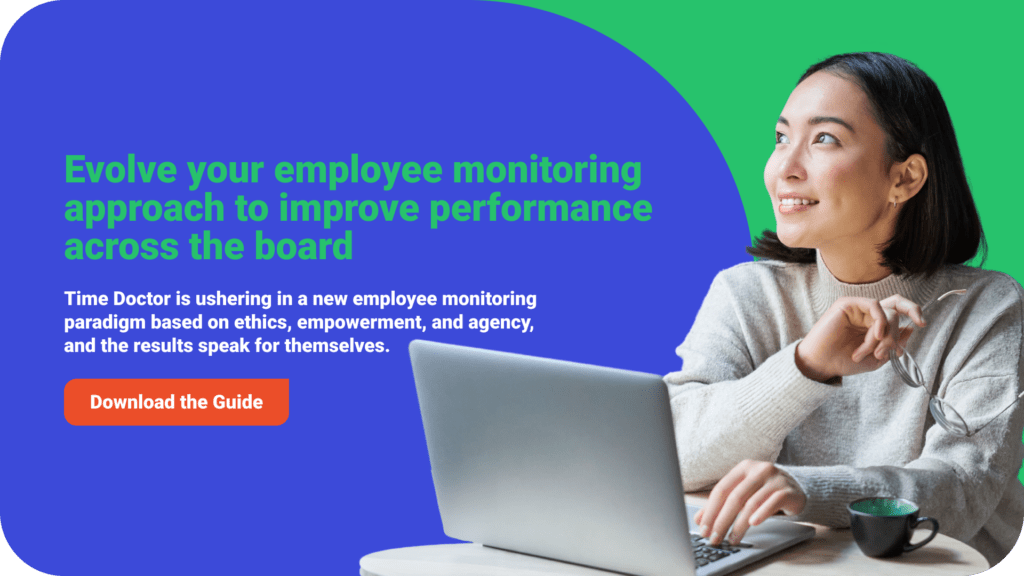The unfortunate legacy of employee monitoring has less to do with employee monitoring per se and more to do with management philosophies rooted in compliance and hierarchy.
Early employee monitoring methods evolved from top-down, compliance-first management styles. As a result, the approaches relied on methods that weren’t exactly employee-friendly:
- Monitoring activity without telling workers
- Recording and monitoring intracompany communication
- Assessing performance on task-based metrics
- Docking pay based on blanket rules about productive time
- Penalizing or even terminating employees based on rigid metrics
Collaboration isn’t built in. Employees aren’t given agency. Well-being takes a backseat to hours worked. The lack of empathy and ethics in many employee monitoring software systems is a symptom of a philosophy that is thankfully on the way out.
In contrast, monitoring tools that extend from an ethical, improvement-focused management approach are a powerful force for good. They instill a sense of agency and help employees master their own productivity.

Transparency and trust are good for business
A 2021 study looked at the effectiveness of employee monitoring as a deterrent to “devious” behavior. The researchers found that, in a culture of mistrust, “monitored employees may actually engage in higher levels of deviance”, for example, by working slowly or taking unscheduled breaks. When positioned as a deterrent, monitoring undermines employees’ feeling of agency .
Managers who focus on improvement rather than punishment will hardly find these results surprising.Compliance is about the best you can hope for when workers feel scrutinized instead of supported. Innovation is off the table. Motivation to excel vanishes. The problem isn’t the fact of employee monitoring but the purpose. By focusing on deviant behavior, companies are signaling their mistrust. By secretly spying, they’re confirming that signal. Employees, being human, respond as humans would. If you’ve read 1984, you already know how the story ends.
Employees aren’t against the idea of monitoring. They just want to be informed.
- 77% of US employees would be fine with employee monitoring if the company was transparent and let them know upfront (source)
- 64% agreed that monitoring devices for security reasons is perfectly fine – again, provided the employer is transparent (source)
- 62% would be comfortable with monitoring on work-issued devices if the data was anonymized, and 36% feel the same about personal devices (source)
- 50% of workers were comfortable with monitoring when the employer explained the reasons for it (source)
Amid the Great Resignation, when 59% of employees are quiet quitting and 18% are actively disengaged, companies can’t afford to ostracize their best-performing people. They must engage and empower employees using every tool at their disposal.
Employee monitoring is one such tool with the potential to be a powerful force for good. Provided, that is, it’s in the right hands and embedded in a broader context of organizational improvement.
Creating the conditions for improvement-inspired employee monitoring
Traditional models of employee surveillance have given way to a new paradigm. Improvement-focused employee monitoring is a new approach that uses data to empowers individuals to reach their full potential, rather than punish them for mistakes.
Employee monitoring can be a powerful tool for improving performance, but ethical and respectful use is paramount. This approach is more likely to be effective in the long run as it builds trust between managers and employees, and motivates individuals to excel.
When done right, the new approach engages employees and creates the conditions for adaptability, innovation and collaboration.
Considerations for an improvement-focused employee monitoring program
- Set clear expectations: What do you hope to achieve by monitoring employees? What are the specific behaviors that you are trying to measure? What communication, feedback and support can employees expect?
- Use productivity analytics for good: Don’t use the data to punish employees unless absolutely necessary. Use it to help them identify areas where they can improve and provide them with the support they need to succeed.
- Be transparent and accountable: Be open with employees about the monitoring program and how their data will be used. Be accountable for the use of the data and make sure that it is used in a way that is ethical and respectful.
- Review regularly and remain agile: As your business needs change, you may need to adjust your monitoring program. Review the program to make sure it is working for employees, managers and organizational leaders.
The evolution of employee monitoring reflects a transition from antiquated, compliance-driven philosophies to a more ethical and empowerment-focused approach. The negative legacy of monitoring methods rooted in mistrust and rigidity is being replaced by a paradigm that prioritizes transparency, collaboration, and employee agency. The shift towards improvement-focused management acknowledges the potential of monitoring tools as a force for good, empowering individuals to reach their full potential rather than stifling innovation.
The key lies in clear expectations, ethical use of data, transparency, and adaptability. As the business landscape undergoes transformations, organizations must recognize that fostering trust and creating conditions for improvement-inspired monitoring are essential for engaging and retaining top talent. The new approach not only benefits individual performance but also cultivates a culture of adaptability, innovation, and collaboration, essential elements for success in the ever-evolving professional landscape.
Change is not instant. It’s a process that requires commitment, patience and adaptability. But the rewards are worth it.

Carlo Borja is the Content Marketing Manager of Time Doctor, a workforce analytics software for distributed teams. He is a remote work advocate, a father and a coffee junkie.


